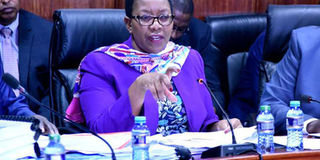Premium
No value for Kenyans in costly medical services scheme

Health Cabinet Secretary Sicily Kariuki gives senators insights on the Managed Equipment Service (Mes) programme on October 22, 2019. The programme has not achieved its intended purpose. PHOTO | FILE | NATION MEDIA GROUP
What you need to know:
- The scheme was initiated in 2015 as an alternative healthcare financing option to scale up access to specialised care.
- The study recommends that national and county governments foster an inter-governmental framework approach for undertaking an evaluation and reconfiguration of the project.
There seems to be no end in sight to the controversy that has been the trademark of the Managed Equipment Service (Mes) programme, with a study by the Institute of Economic Affairs revealing that poor regulation of the project has increased financial and corruption risks.
Since 2015 when the programme started, many grey areas and unanswered questions still exist.
This is even as Health Cabinet Secretary Sicily Kariuki faces a Senate ad hoc committee to explain the circumstances that led to the cancellation of a Sh4.9 billion contract won by Seven Seas Technology Limited in 2017.
The firm had signed the Information Communication Technology (ICT) services contract covering all 98 hospitals under the Mes programme.
The study, dubbed “Value for Money Assessment”, also revealed that besides lack of transparency on the project in regard to the terms and conditions of the contract, the project has been a burden to taxpayers.
“The design of the Mes project was not informed by comprehensive disease burden and health infrastructure needs assessment, given that counties are not homogeneous,” says the study.
SPECIALISED CARE
The leasing of medical equipment was initiated as an alternative healthcare financing option to scale up access to specialised care.
The study sought to evaluate the worthiness or value for money of the Mes, present some facts and demystify the project and whether this was the most cost-effective intervention especially as a public-private partnership.
The assessment revealed that six different private firms were contracted by the government to equip two hospitals per county and four national referral hospitals with different sets of equipment.
The project was under a seven-year contract worth Sh38 billion, which went up to Sh63 billion after 21 hospitals were added,
hence increasing the counties’ allocation from Sh97.7 million in the initial phase to Sh200 million, with counties saying there has been no explanation for this.
POOR GROUNDWORK
Each county will pay Sh131.9 million in the year to June 2020. Each devolved unit paid Sh95.7 million for the kits in the 2015/16, 2016/17 and 2017/18 financial years.
“This has not been the case. About four years into the project, we found out that there are cost variations. Due to transparency issues, it was unclear whether the project cost is inclusive of suppliers’ obligations, beyond supply and installation of equipment (training, repairs, replacement and insurance costs),” says Mr John Mutua, the programmes coordinator, IEA.
Mr Mutua said that the project was not informed by a county health needs assessment exercise.
For instance, counties were making payments of equal amounts yet they would not benefit from the same set of equipment. There was unlawful and ineffective utilisation of public funds allocated to the implementation of the project.
From the government reports, it revealed that the delivery of medical equipment was 100 per cent based on the targets by the end of 2018/19.
But from the audit findings, it is contrary. “Two cases of no value for money were seen through the project,” said Mr Mutua.
INADEQUATE INFRASTRUCTURE
One, he said there was underutilisation of delivered medical equipment largely due to lack of personnel and supporting infrastructure in some health centres.
Secondly, to date, some health facilities have not received the equipment. “This patently suggests poor service delivery results,” Mr Mutua said.
For instance, the study revealed that in Uasin Gishu, theatre equipment was delivered and installed at Burnt Forest Sub-District Hospital; however, the equipment was not effectively being utilised due to lack of a blood transfusion fridge for storage of blood.
This is despite the county reporting 4,915 cases of road traffic injuries in 2017 and 5,345 cases of burns in which below five accounted for 38 per cent, according to KNBS 2018.
Some equipment is yet to be utilised in Baringo, Kericho, Turkana and Vihiga counties.
SPECIAL AUDIT
A majority of the 123 hospitals earmarked as beneficiaries of the Mes project are not using the equipment.
The study recommends that national and county governments foster an inter-governmental framework approach for undertaking an evaluation and reconfiguration of the project.
It also suggests the redistribution of medical machines. “Despite the counties making annual payments, there is a need for a redistribution of machines and supporting infrastructure as well as health needs. As a result, the lease payments should be revised accordingly,” the study suggests.
It also recommends transparency and a special audit of the project.




